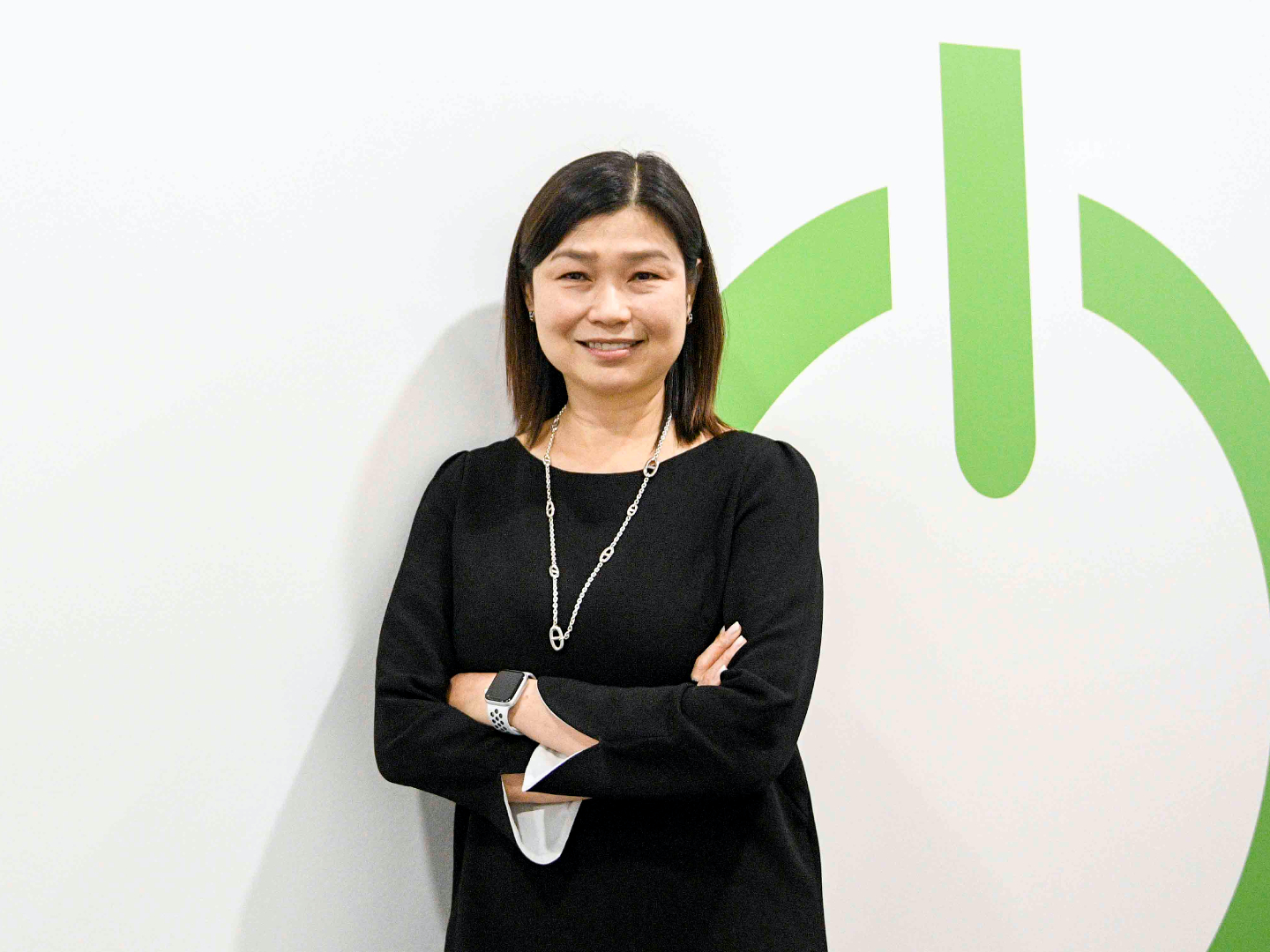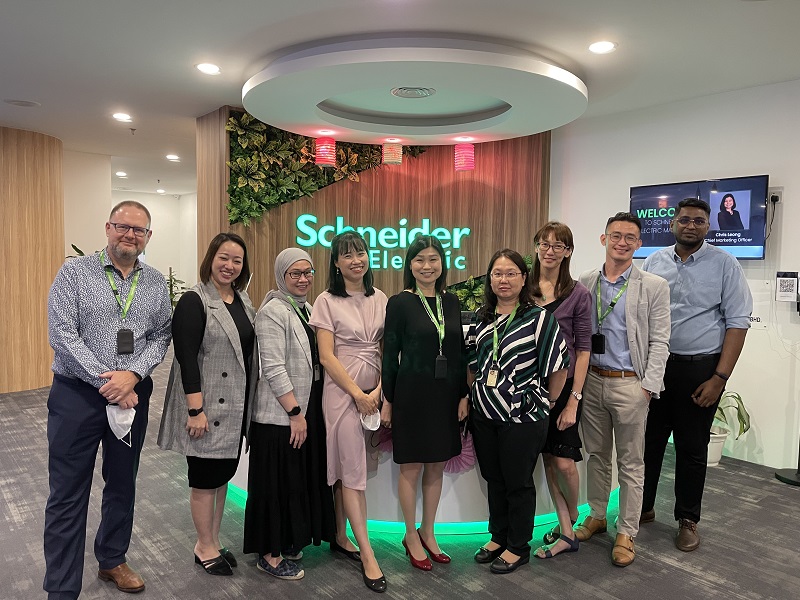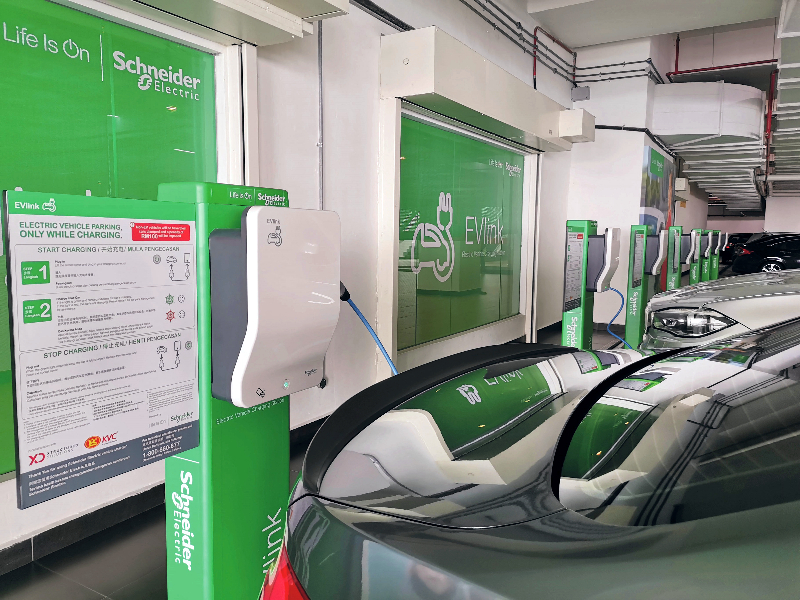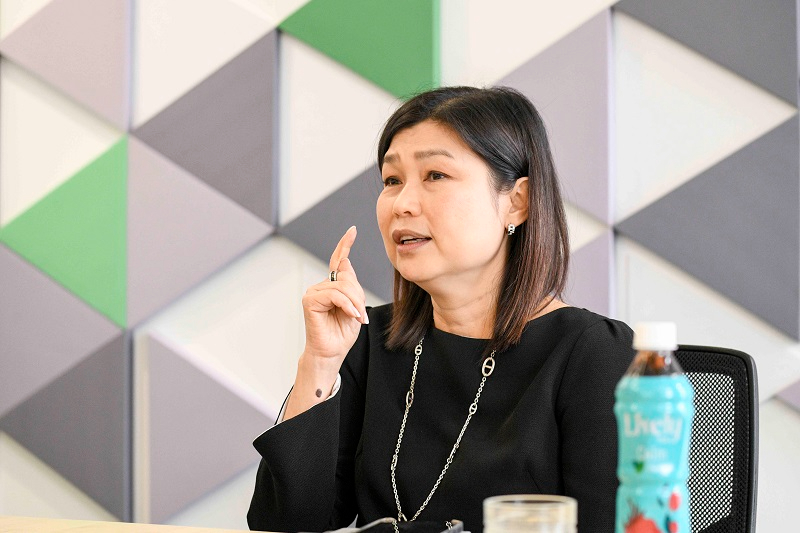
Leong ensures that the brand understands what it sells (Photo: Shahrill Basri/ The Edge Malaysia)
From growing up in the backwaters of Kuala Lumpur with no electricity and running water to being chief marketing officer of a world-leading energy management company reads like coming full circle. Ask Schneider Electric CMO Chris Leong how that feels and her reply is typical of a doer.
“Well, the job is not done, that’s what I would say. Previous generations did not know about climate change; ours is very clear about it. So, you could create a mess, or you could clean it up.”
With the higher adoption rate of renewables and energy efficiency solutions, for which the technology exists, companies can drive an even better planet for future generations. “We have no excuse. The mess is already there, and you don’t need permission to be part of the solution,” she emphasises.
It takes time and the next generation is more natively inclined to do something, to understand climate change in more literal terms. There are more solutions and technology available today, compared to 20 years ago, and climate literacy is higher. “And I do think success breeds success.”
Success is a word you would associate with Leong — one of Forbes World’s Most influential CMOs (she is #25 on this year’s list) — who started her career journey as a part-time waitress at a Kentucky Fried Chicken outlet in Setapak, KL. Over four-and-a-half years, she became a trainer for the floor staff, was in marketing, then catering services at the head office. "I consider KFC my first training ground and still keep in touch with my bosses, mentors for life."
Between 1991 and 2005, she worked with advertising agencies in Malaysia, Singapore, Hong Kong and London, across different product categories. She then joined Nokia, where she held several roles, including senior vice-president, global marketing. When she left in 2011, she was senior vice-president for Greater China, Japan and Korea.
Leong joined Schneider in 2012 because she found it fascinating. The tech company’s role of providing sustainability solutions for customers was “something I didn’t know or understand. Something for me to learn”. Learning on the job falls into place for this self-starter who says there was nobody to show her the way to go when growing up or help map her career path.
chris_leong_malaysia.jpg

“There were only two things for me: I wanted to do the best of whatever I was given. Not because I had to answer to the boss or wanted to get promoted. And I wanted self-satisfaction. It didn’t matter if I was in KFC cooking chicken; I wanted to cook the best chicken. If I was in charge of training, I wanted my staff to be the best in customer service.
“You want to do something because it is fulfilling for yourself. I genuinely believe work ethics are important. If you work hard, if you are passionate about what you do, if you’re committed, everybody is dying to promote you. It will come.
“I tell you, talent is very scarce. When you see great talent with great ideas, great ethics, you’re going to promote it like there’s no tomorrow. You want to groom and grow that talent. At Schneider, we like to have our talent exchanging jobs in different geographies.” Which brings her to the why, who, where and how behind its decision to be “the most local global company”, on top of doing what it does.
Schneider staff are located across more than 100 countries, in close proximity to the populace — to design, produce and serve them better. This means first-hand insights for its innovations, agile supply chain for lower carbon footprint and fully empowered local teams for fast decision-making, Leong explains in a video clip. It means value diversity and inclusion above all else, with equal opportunity for career progression in the organisation.
She exemplifies that: A Malaysian-born Chinese woman, not an engineer, now serving as an executive committee leadership team member in one of Fortune’s 2022 World’s Most Admired Companies. Three years after joining Schneider, she was promoted to CMO in 2015.
“My role is to clarify who we are and who we are not. We’re in the business of helping with sustainability, thanks to digitalisation and electrification solutions. I’m also in charge of all marketing activities and creating awareness: People have to know who you are and what you do or sell.”
Schneider is in 40% of buildings worldwide but remains the world’s largest “invisible” brand. “We’re normally in the basement or behind the wall. People don’t see us but we’re providing them safety, reliability, efficiency, connectivity and sustainability.”
Leong also ensures that the brand understands what it sells, from EcoStruxure, an IoT solution to help data centres and industries, to an EcoStruxure augmented operator that can look inside a machine at the manufacturing plant to diagnose what’s wrong with it. This sidesteps having to deal with voltage, which can be dangerous.
There is software to design digital twins of plants before they are built, to simulate the processes which will be carried out there, and how the machines should be laid out and where, for example, to save all the planning while driving efficiency.
Oil companies use Schneider software to train their engineers before they head out for offshore platforms, as preparation. It is fun, like a video game with high imagery, but the objective is serious — safety and productivity.
Traditional marketing strategies remain important because the fundamentals do not change, Leong adds: target audience, pain points and needs. What’s your value proposition? What does the brand stand for? What are you selling?
The same logic applies, whether you are selling ice cream, lipstick, a car, a building, or a technical solution. “When you are selling shoes to a teenager, his pain point is he needs to have a sense of belonging with all the other teens. The value proposition would be: This gets you into the clique to which you belong.”
Going back to Forbes’ recognition of her influence — she was also on the CMO list in 2017 and 2018 — she says, frankly, it means much more to her team than her. “If you look at the top 50, it’s usually those from consumer goods and tech. We seldom see B2B industrial names. If you do engineering, you might decide to join Schneider. If you want to do marketing, you might join Nestlé. Because I’m on the list, it gives my team, marketers, hope that they can do big, big work as well.”
Schneider, voted the most sustainable company in the world out of over 8,000 corporations in 2021, may not be “visible” but its purpose — empowering everyone to make the most of available energy and resources because access to energy and digital is a basic human right — is felt everywhere.
“We are in the business of leading digital transformation for energy management and automation. Why is that important? Because we are currently experiencing the single-biggest energy transition of our lifetime. More people are moving to the big cities, so you need more food, infrastructure, schools, homes. Look at EV (electric vehicles) penetration. All these are going to need more energy. At the rate we are going, we are going to need twice as much by 2050.”
More energy usage equals more greenhouse gas emissions. Compound that with floods and wildfires in different parts of the world, which point to climate change. At the same time, there is the United Nations’ goal of limiting global warming to 1.5°C — which means we need to be four times more efficient in the way we utilise energy. Is that possible?
“Yes, if you use Schneider, you can,” Leong says, confidently. “Technology exists with which you can manage energy use in buildings and be more efficient.”
The company deals mainly with B2B industries, but the work it does is relevant to people’s day-to-day life. Leong uses a simple example: Schneider serves one in two data centres around the world. To enjoy the digital platforms around us, we need reliable and efficient data centres. Schneider’s solutions in, say, a college campus, mum’s office, school, manufacturing plant, hospital, airport, train station, power grid and water system ensure that things around us work in a safe, efficient, reliable, connected and sustainable manner.
On the other hand, there are still 1.3 billion people around the world who have intermittent or no energy supply. “That’s also a problem. We can’t say just because the West has enjoyed everything and then we have climate problems, we have to stop those with no access to electricity from having it. You can’t do that because we still want to drive progress and sustainability for all. Progress and sustainability are not two parallel universes. They are not binary. We can achieve both because we want to ensure ‘Life is On’ for everyone, everywhere at any moment.”
This is not just a tagline for Schneider, which walks the talk by setting targets that impact its shareholders, employees, customers and the community. “We want to be in a business where we ourselves are practising sustainability. Our products have end-of-life treatment and we want to have zero landfill.”
There is no virgin plastic in all of Schneider’s packaging and the ink in its carton boxes comes from vegetables. “There are no chemical toxins, and we’re not even selling food. But it’s right for the environment. We are working with 1,000 suppliers of our own to reduce their CO2 emissions by half. We’re going to go fully EV worldwide. I am excited because I am in the business of executing sustainability, not talking about it.”
img_20191004_124102.jpg

How is this going to be executed in Malaysia versus Germany, versus the US or Colombia?
“I cannot do it and I wouldn’t know either, even if I pretend to. I would rely on my teams with the local know-how to translate the vision into reality locally. For them to rally and inspire stakeholders to want to join. It’s not a crusade; it’s an actionable plan to deliver something that’s concrete in the only one planet we all live in,” Leong says.
“My job is to set the vision, to support my chairman and CEO on where we want to drive the company and use my marketing skills to deliver it through a brand voice, through market outreach, through the positioning of a company and brand that is desirable and able to engage in how we would support companies in co-developing solutions for the world.”
Turning plans into action requires slightly different translations but the essence and outcome are the same, she thinks. “The way you want to evoke a response, an action with an Indonesian customer or a Japanese one is not the same because there are cultural nuances, and different development stages and policies in those countries. But we want to ride on because we operate as part of the environment.”
People need a combination of carrot and stick to move them to take action and many countries have stimulus that help with the energy transition. On its part, Schneider has placed self-imposed sustainability KPIs into the bonus system for the group.
“If we don’t manage to do what we want, we don’t get our bonus. Then we say, we want to drive a company that promotes diversity; we want to hire 50% of women onboarding; have women make up 40% of our frontline managers and at least 30% of top leaders. If we don’t achieve that, we don’t get our bonuses,” Leong adds, with a smile and a nod.
As a leader who has enjoyed having many good mentors throughout her career, she believes in being one too. “It doesn’t matter what level you are at, we are always responsible for the next generation, to help juniors, to liberate, motivate and inspire them to go beyond the sector and industry they are in.”
20220908_peo_ms_chris_leong_sb_10.jpg

Why? “The single most important asset a company can have is human capital. You can have exactly the same product and head count and spend on the same things, but if in one place the people are more motivated, more self-driven to resolve issues, have laser-sharp focus on customers and really want to innovate and create the future, that’s what’s going to make the difference between company A and B.”
Perhaps like how Leong’s mentors saw potential in her, this mother of two college-going boys is hopeful of the young and passionate about driving them to deliver at the next level.
“They are not shy. They will question and if they don’t like what they hear, they will leave. In a way, you have to embrace that and look at it as a good thing.”
Schneider has launched a programme called global marketing hearts under which its marketing team volunteers every month at NGOs that need help — to set up a new website perhaps, write a press release or organise a fundraiser.
Staff can deduct X amount of time from work to contribute to this. They are practising their skillset and competency in marketing while doing something purposeful on a personal level that’s fulfilling, she notes.
There is no hierarchy; the most junior person can be a project leader. And one team may have people from Dubai, Germany, Indonesia and Malaysia all working together to solve someone’s problems. “We are used to it because we do global things.”
She herself is based in Hong Kong but travels a lot for work, as well as pleasure. Before her recent visit back to KL, she spent four days in a place near Tuscany. “It was really nice going mountain walking, being on a boat, seeing old castles, having a gelato every day and catching up with friends.
“Maybe it’s an age thing. Everywhere I go, I like catching up. We all have busy lives but I think it’s precious. I still keep in touch with my schoolmates — tomorrow we’re going to makan — and my KFC and agency friends,” says Leong, 54 this year. She does kickboxing and enjoys hiking and cooking. “Someone else has to wash up.”
She sees herself continuing in marketing because “that’s what I love and there is still a lot of uncharted territory, especially in the B2B market. There’s lots of emphasis on B2C, which is more glam, visible and faster, with promotions, excitement and celebrities. With B2B, you’re trying to educate and bring customers with you to solve big issues.”
This article first appeared on Oct 31, 2022 in The Edge Malaysia.


